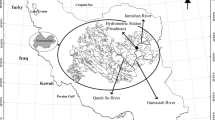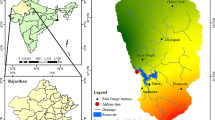Abstract
Predicting the reservoir inflows plays a central role in the control and management of water resources and the related activities, such as the reservoir exploitation and flood/drought control. The complex nature of the hydrological systems and difficulties in their application processes have urged the researchers to look for more efficient reservoir-inflow modeling methods. Aimed at this objective, the current study developed three SVM-GA, ANFIS-GA and ARIMA-LSTM hybrid models, compared their performances with one another as well as with LSTM, SVM, ANFIS and ARIMA models and SWAT hydrological model in predicting the inflows to the Droodzan Dam reservoir in Fars Province, Iran, and evaluated their results using such statistical criteria as the RMSE, MAE, MAPE, MSE and R2. In short, the results revealed that the combined methods performed better than the single models and ARIMA-LSTM and LSTM predicted the monthly reservoir inflows more accurately (R2 = 0.9272, 0.8805, training, and R2 = 0.9097, 0.8148, testing). Among the three combined and four single studied models, ARIMA-LSTM showed higher accuracy and had better potential in predicting the monthly reservoir inflows in arid and semi-arid regions.



















Similar content being viewed by others
References
AlDahoul N, Ahmed AN, Allawi MF, Sherif M, Sefelnasr A, Chau KW, El-Shafie A (2022) A comparison of machine learning models for suspended sediment load classification. Eng Appl Comput Fluid Mech 16(1):1211–1232
Allawi MF, Ahmed ML, Aidan IA, Deo RC, El-Shafie A (2021a) Developing reservoir evaporation predictive model for successful dam management. Stoch Env Res Risk Assess 35:499–514
Allawi MF, Aidan IA, El-Shafie A (2021b) Enhancing the performance of data-driven models for monthly reservoir evaporation prediction. Environ Sci Pollut Res 28:8281–8295
Allawi MF, Hussain IR, Salman MI, El-Shafie A (2021c) Monthly inflow forecasting utilizing advanced artificial intelligence methods: a case study of Haditha Dam in Iraq. Stoch Env Res Risk Assess 35(11):2391–2410
Asefa T, Kemblowski MW, McKee M, Khalil A (2006) Multi-time scale stream flow predictions: the support vector machines approach. J Hydrol 318:7–16
Bai Y, Xie J, Wang X, Li C (2016) Model fusion approach for monthly reservoir inflow forecasting. J Hydroinf 18(4):634–650
Bai Y, Sun Z, Zeng B, Long J, Li C, Zhang J (2018) Reservoir inflow forecast using a clustered random deep fusion approach in the Three Gorges Reservoir, China. J Hydrol Eng 23(10):04018041
Box GEP, Jenkins GM (1976) Time series analysis, forecasting and control. Holden-Day, San Francisco
Box GEP, Jenkins GM, Reinsel GC (2008) Time series analysis: forecasting and control, 4th edn. Wiley and Sons, New Jersey
Bozorg-Haddad O, Aboutalebi M, Ashofteh PS, Loáiciga HA (2018) Real-time reservoir operation using data mining techniques. Environ Monit Assess 190(10):1–22
Chau KW, Wu CL, Li YS (2005) Comparison of several flood forecasting models in Yangtze River. J Hydrol Eng 10(6):485–491
Coulibaly P, Haché M, Fortin V, Bobée B (2005) Improving daily reservoir inflow forecasts with model combination. J Hydrol Eng 10(2):91–99
Dariane AB, Azimi S (2018) Streamflow forecasting by combining neural networks and fuzzy models using advanced methods of input variable selection. J Hydroinf 20(2):520–532
Dibike YB, Yelickov S, Solomatine DP, Abbott MB (2001) Model induction with support vector machines: introduction and application. J Comput Civil Eng Manag 15(3):208–216
Duan T, Sicard A, Glémin S, Lascoux M (2024) Separating phases of allopolyploid evolution with resynthesized and natural Capsella bursa-pastoris. eLife 12:RP88398. https://doi.org/10.7554/eLife.88398.3
Ehteram M, Afan HA, Dianatikhah M, Ahmed AN, Ming Fai C, Hossain MS, Elshafie A (2019) Assessing the predictability of an improved ANFIS model for monthly streamflow using lagged climate indices as predictors. Water 11(6):1130
Eslamian S, Eslamian F (eds) (2022) Handbook of HydroInformatics: Volume I: Classic Soft-Computing Techniques. . Elsevier, UK
Giuliani M, Quinn JD, Herman JD, Castelletti A, Reed PM (2017) Scalable multiobjective control for large-scale water resources systems under uncertainty. IEEE Trans Control Syst Technol 26(4):1492–1499
Hochreiter S, Schmidhuber J (1997) Long short-term memory. Neural Comput. https://doi.org/10.1162/neco.1997.9.8.1735
Khadr M, Schlenkhoff A (2018) Data-driven stochastic modeling for multi-purpose reservoir simulation. J Appl Water Eng Res 6(1):40–47
Khorram S, Jehbez N (2023) A hybrid CNN-LSTM approach for monthly reservoir inflow forecasting. Water Resour Manage 37:4097–4121
Kim T, Heo JH, Jeong CS (2006) Multireservoir system optimization in the Han River Basin using multi-objective genetic algorithms. Hydrol Process 20(9):2057–2075
Kişi Ö (2004) River flow modeling using artificial neural networks. J Hydrol Eng 9(1):60–63
Koycegiz C, Buyukyildiz M (2019) Calibration of SWAT and two data-driven models for a data-scarce mountainous headwater in semi-arid Konya closed basin. Water 11(1):147
Kratzert F, Klotz D, Brenner C, Schulz K, Herrnegger M (2018) Rainfall–runoff modelling using long short-term memory (LSTM) networks. Hydrol Earth Syst Sci 22(11):6005–6022
Lee SY, Hamlet AF, Fitzgerald CJ, Burges SJ (2009) Optimized flood control in the Columbia River Basin for a global warming scenario. J Water Resour Plan Manag 135(6):440–450
Liu J, Yan K, Zhao X, Hu Y (2016) Prediction of autogenous shrinkage of concretes by support vector machine. Int J Pavem Res Technol 9(3):169–177
Loukika KN, Venkata Reddy K, Durga Rao KHV, Singh A (2020) Estimation of Groundwater Recharge Rate Using SWAT MODFLOW Model. In: Ghosh JK, da Silva I (eds) Applications of Geomatics in Civil Engineering: Select Proceedings of ICGCE 2018. Springer Singapore, Singapore, pp 143–154. https://doi.org/10.1007/978-981-13-7067-0_10
Mohammadi, K., Eslami, H. R., & Dayani, D. S. (2005). Comparison of regression, ARIMA and ANN models for reservoir inflow forecasting using snowmelt equivalent (a case study of Karaj).
Nadiri AA, Shokri S, Tsai FTC, Moghaddam AA (2018) Prediction of effluent quality parameters of a wastewater treatment plant using a supervised committee fuzzy logic model. J Clean Prod 180:539–549
Noori R, Karbassi AR, Mehdizadeh H, Vesali NM, Sabahi MS (2011) A framework development for predicting the longitudinal dispersion coefficient in natural streams using an artificial neural network. Environ Prog Sustain Energy 29:439–449
Oliveira R, Loucks DP (1997) Operating rules for multireservoir systems. Water Resour Res 33(4):839–852
Pradhan P, Tingsanchali T, Shrestha S (2020) Evaluation of soil and water assessment tool and artificial neural network models for hydrologic simulation in different climatic regions of Asia. Sci Total Environ 701:134308
Raihan F, Beaumont LJ, Maina J, Saiful Islam A, Harrison SP (2020) Simulating streamflow in the Upper Halda Basin of southeastern Bangladesh using SWAT model. Hydrol Sci J 65(1):138–151
Raso L, Chiavico M, Dorchies D (2019) Optimal and centralized reservoir management for drought and flood protection on the Upper Seine-Aube river system using stochastic dual dynamic programming. J Water Resour Plan Manag 145:05019002
Reddy MJ, Kumar DN (2006) Optimal reservoir operation using multi-objective evolutionary algorithm. Water Resour Manag 20(6):861–878
Schardong A, Simonovic SP, Vasan A (2013) Multiobjective evolutionary approach to optimal reservoir operation. J Comput Civ Eng 27(2):139–147
Valipour M, Banihabib ME, Behbahani SMR (2013) Comparison of the ARMA, ARIMA, and the autoregressive artificial neural network models in forecasting the monthly inflow of Dez dam reservoir. J Hydrol 476:433–441
Vapnik VN (1995) The nature of statistical learning theory. Springer New York, New York. https://doi.org/10.1007/978-1-4757-2440-0
Wang J, Du YH, Zhang XT (2008) Theory and application with seasonal time series, 1st edn. Nankai University Press, Nankai
Wang ZY, Qiu J, Li FF (2018) Hybrid models combining EMD/EEMD and ARIMA for Long-term streamflow forecasting. Water 10(7):853
Wenjian W, Changqian M, Weizhen L (2008) Online prediction model based on support vector machine. Neurocomputing 71(5):550–558
Yafouz A, AlDahoul N, Birima AH, Ahmed AN, Sherif M, Sefelnasr A, Elshafie A (2022) Comprehensive comparison of various machine learning algorithms for short-term ozone concentration prediction. Alex Eng J 61(6):4607–4622
Yang CC, Chang LC, Yeh CH, Chen CS (2007) Multiobjective planning of surface water resources by multiobjective genetic algorithm with constrained differential dynamic programming. J Water Resour Plann Manag 133(6):499–508
Zhang GP (2003) Time series forecasting using a hybrid ARIMA and neural network model. Neurocomputing 50:159–175
Zhang Z, Zhang Q, Singh VP (2018) Univariate streamflow forecasting using commonly used data-driven models: literature review and case study. Hydrol Sci J 63(7):1091–1111
Zhang D, Peng Q, Lin J, Wang D, Liu X, Zhuang J (2019) Simulating reservoir operation using a recurrent neural network algorithm. Water 11(4):865
Zhu S, Zhou J, Ye L, Meng C (2016) Stream flow estimation by support vector machine coupled with different methods of time series decomposition in the upper reaches of Yangtze River, China. Environ Earth Sci 75(531):1–12
Author information
Authors and Affiliations
Corresponding author
Rights and permissions
Springer Nature or its licensor (e.g. a society or other partner) holds exclusive rights to this article under a publishing agreement with the author(s) or other rightsholder(s); author self-archiving of the accepted manuscript version of this article is solely governed by the terms of such publishing agreement and applicable law.
About this article
Cite this article
Khorram, S., Jehbez, N. Enhancing Accuracy of Forecasting Monthly Reservoir Inflow by Using Comparison of Three New Hybrid Models: A Case Study of The Droodzan Dam in Iran. Iran J Sci Technol Trans Civ Eng (2024). https://doi.org/10.1007/s40996-024-01418-5
Received:
Accepted:
Published:
DOI: https://doi.org/10.1007/s40996-024-01418-5




